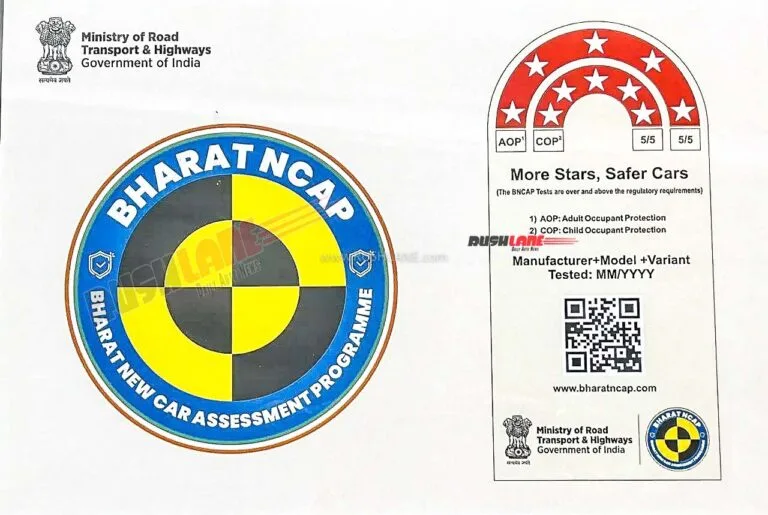Bharat NCAP Safety Rating Protocol: A Comprehensive Overview
The Bharat NCAP safety rating protocol, encompassing frontal impact, side impact, and side pole impact tests, plays a pivotal role in determining the star rating for both adult occupants (AOP) and child occupants (COP).
Introduction to Bharat New Car Assessment Program (Bharat NCAP)
Initiated by the Ministry of Road Transport and Highways under the visionary leadership of Union Minister Nitin Gadkari, the Bharat New Car Assessment Program (Bharat NCAP) has been introduced to revolutionize the automotive industry in India. This program aligns with the Automotive Industry Standard (AIS) 197, enabling automakers to submit their vehicles for comprehensive testing. The impact of BNCAP extends beyond the safety-conscious buyer, fostering global competitiveness among automakers, promoting safer driving practices, alleviating healthcare burdens, and eliciting incentives from the insurance sector.
The Advantages of Testing Vehicles under Bharat NCAP
Commencing on October 1, 2023, Bharat NCAP will make India the fifth nation globally to implement its crash testing rating system. As testament to its success, over 30 vehicles have already undergone crash testing under Bharat NCAP. This endeavor incurs a cost of approximately Rs. 60 lakh within India, compared to the escalated cost of Rs. 2.5 crores for overseas testing. Although participation in Bharat NCAP testing is voluntary, the shift in consumer preferences towards safety will undoubtedly encourage automakers to adhere to these stringent norms. This shift will empower buyers with safety-related insights, fostering informed decisions. Furthermore, it promises to mitigate the risk of road accidents and fatalities while enhancing automakers’ market share and global competitiveness. This initiative also catalyzes the development of cutting-edge components and fosters innovation within the industry.
Eligibility Criteria for Cars under Bharat NCAP Crash Test Regulations
Bharat NCAP adheres to specific eligibility criteria. Vehicles falling within the M1 category, approved for carrying up to 8 passengers along with 1 driver, are eligible for assessment. These vehicles must possess a gross weight lower than 3.5 tonnes and can be either domestically manufactured or imported. Bharat NCAP encompasses all combustion engine, CNG, and electric vehicles.
Comprehensive Assessment Under Bharat NCAP
Cars subjected to Bharat NCAP undergo evaluations encompassing frontal impact, side impact, and side pole impact. These assessments are categorized into three crucial areas: Adult Occupant Protection (AOP), Child Occupant Protection (COP), and Fitment of Safety Assist Technologies. Vehicles are assigned star ratings ranging from 1 to 5, with 5 stars denoting the highest rating. Separate star ratings are allocated for AOP and COP.
Frontal Impact Tests
Frontal impact tests are conducted at speeds of 64 km/h or 40 mph. During these tests, vehicles collide with a deformable barrier, impacting 40 percent of the front width on the driver’s side. The methodology mirrors that of Global NCAP tests, incorporating crash test dummies to assess the protection of adults in the front seat. Moreover, cars must comply with pedestrian protection norms. Vehicles attaining safety ratings of 3 stars or higher are subjected to an additional pole-side impact test.
Side Impact and Pole-Side Impact Tests
Side impact tests are executed at 50 km/h, while pole-side impact tests occur at 29 km/h. Both categories are subject to maximum and minimum points, determining the vehicle’s star rating. For instance, a vehicle must be equipped with front seat belt reminders and electronic stability control to secure a three-star rating. Bharat NCAP star ratings encompass a maximum of 32 points for AOP and 49 points for COP.
The Procedure for Conducting Crash Tests under Bharat NCAP
The process for conducting crash tests under Bharat NCAP unfolds as follows:
- Automaker Nomination: The automaker must nominate a specific vehicle for crash testing.
- Vehicle Selection: Representatives from Bharat NCAP visit the automaker’s stockyard and randomly select a base variant of the vehicle.
- Testing at Bharat NCAP Facility: The chosen vehicle is transported to the Bharat NCAP facility, where it undergoes comprehensive testing. Automaker representatives, along with BNCAP officials, bear witness to the tests.
- Test Results and Certification: Following the tests, the results are compiled and shared with the automaker. Subsequently, the results are published, and a certificate is issued by the Central Institute of Road Transport.
Conclusion: Promoting Safety and Beyond
In conclusion, Bharat NCAP’s commitment to enhancing car safety is commendable. Minister Gadkari has called upon organizations like the Automotive Research Association of India and the National Automotive Test Tracks to establish in-house crash testing facilities. Additionally, raising awareness about road engineering is essential to curbing accidents and fatalities on India’s roads. Currently, the country experiences a staggering 47 accidents and 18 fatalities per hour, with 70 percent of these fatalities occurring within the age group of 18-34. Bharat NCAP’s comprehensive approach is a significant step toward safer roads and a more secure automotive future for India.
